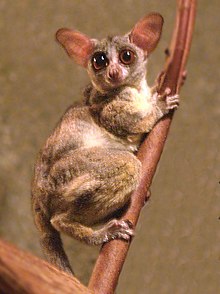Senegal bushbaby
| Senegal bushbaby | |
|---|---|
 |
|
| Scientific classification | |
| Kingdom: | Animalia |
| Phylum: | Chordata |
| Class: | Mammalia |
| Order: | Primates |
| Family: | Galagidae |
| Genus: | Galago |
| Species: | G. senegalensis |
| Binomial name | |
|
Galago senegalensis É. Geoffroy, 1796 |
|
 |
|
|
Distribution of the Senegal Bushbaby
Possible range or accidental records
|
|
The Senegal bushbaby (Galago senegalensis), also known as the Senegal galago, the lesser galago or the lesser bush baby, is a small, nocturnal primate, a member of the galago family Galagidae.
The name "bush baby" may come either from the animals' cries or from their appearance. They are agile leapers, and run swiftly along branches. They live in Africa south of the Sahara and nearby islands including Zanzibar. They tend to live in dry woodland regions and savannah regions. They are small primates (130mm and 95-300 grams) with woolly thick fur that ranges from silvery grey to dark brown. They have large eyes, giving them good night vision; strong hind limbs; and long tails, which help them balance. Their ears are made up of four segments that can bend back individually, to aid their hearing when hunting insects at night. Their omnivorous diet is a mixture of other small animals, including birds and insects, fruit, seeds, flowers, eggs, nuts, and tree gums.
Bushbabies reproduce twice a year, at the beginning of the rains (November) and the end (February). They are polygynous, and the females raise their young in nests made from leaves. They have 1-2 babies per litter, with gestation period being 110–120 days. Bush babies are born with half-closed eyes, unable to move about independently. After a few days, the mother carries the infant in her mouth, and leaves it on convenient branches while feeding.
Adult females maintain territories, but share them with their offspring. Males leave their mothers' territories after puberty, but females remain, forming social groups consisting of closely related females and their immature young. Adult males maintain separate territories, which overlap with those of the female social groups; generally, one adult male mates with all the females in an area. Males who have not established such territories sometimes form small bachelor groups.
Bush babies communicate both by calling to each other and by marking their paths with their urine. At the end of the night, group members use a special rallying call and gather to sleep in a nest made of leaves, in a group of branches, or in a hole in a tree.
A recent study of the Western chimpanzee has revealed that local chimps hunt the Senegal bushbaby using fashioned spears. During the study it was observed that the chimps searched for hollows where a bushbaby might reasonably be expected to sleep. Once such a roost was found, the chimps broke a branch from a nearby tree and sharpened the end using their teeth. They would then rapidly and repeatedly stab into the roost. After a period of stabbing, they removed the wooden spear and tasted or smelled the tip, presumably seeking blood. Once success was confirmed in such a manner they reached into or smashed the roost, retrieved the body of the bushbaby and ate it.
...
Wikipedia

